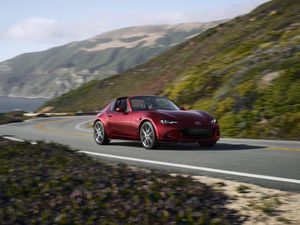The Mazda MX-5 RF is big on style but small on cabin space
Life with the RF has been far from comfortable for the taller members of our team. Darren Cassey compares it to the standard MX-5

When Mazda introduced the new MX-5 it was met with rapturous fanfare from enthusiasts and the automotive media alike. However, it never quite lit my fire in the way it had so many others.
You see, I didn’t feel like it was fast enough – even with the more powerful 158bhp 2.0-litre engine – and it was a bit too soft and wallowy for my sports car tastes.
So when the Retractable Fastback (RF) model was announced I was intrigued, because the suspension would be stiffened to handle the heavier roof, while a hard-top might go some way to adding rigidity.
However, we’re a few months into ‘ownership’ of our long-term RF test car, and I actually think it’s worse than the standard car. And that’s despite costing a few grand more.

At motorway speeds the roof whistles when it’s in place, and buffeting is borderline unbearable with it down. Meanwhile, the stiffer rear suspension has merely made it more fidgety on a back road.
But my biggest beef with the RF is cabin space. Admittedly, with my lanky legs a small roadster isn’t really my cup of tea, but a mainstream model such as this should surely be more accommodating to taller passengers.
To check I wasn’t just imagining things, I booked in a non-RF MX-5 for a test and drove them back-to-back to the seaside. Ignoring the fact it was blowing a gale beside the beach it was perfect roadster weather with blue skies overhead.
And I was pleased to discover that I wasn’t making anything up. The difference is small, but there’s definitely a fraction less space in the RF.

The issue is with the folding roof. Hold the centrally mounted switch on the dashboard and an elaborate metal dance takes place behind your head. The whole rear section of the car lifts and moves backwards, allowing the section above your head to fold backwards and tuck inside.
It’s great to look at, but unlike the cloth, manually folding item on the standard car it takes up a lot more space. There are motors and mechanisms and solid sections of roof to tuck in back there, and cabin space suffers.
I’ll admit, the difference is marginal, but it’s enough to give me a sense of claustrophobia that’s not really present in the standard MX-5. To get my legs comfortable the seat has to be all the way back, but then I have to sit abnormally upright. It results in an annoying compromise that leaves me aching after every long journey. And with the plastic seat back up against the back of the cabin it constantly squeaks. Aggravating.
It leaves me pondering what the point of the RF actually is. In the press pack for the car’s reveal in March 2016, Mazda talked about adding a “new dimension” to the idea of affordable open-top motoring.

However, as far as I can tell, you’re just paying more for a car that amplifies the bad points of the vehicle it is based on.
The one good thing to come out of my comparison test was a new-found fondness for the standard MX-5. Sure, it’s not that powerful, but the 2.0-litre engine in our test car has enough about it that you can get up a fair lick with ease.
And while the soft suspension might make it a bit roly-poly for a track day, for a relaxing drive in the sun it makes the MX-5 a quite comfortable cruiser.
There’s no denying that the RF model gives the MX-5 classy, grown up looks, but I reckon it makes a decent little roadster a little bit worse in every other way.





